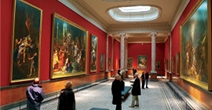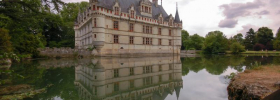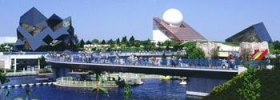 Home
Home- > Tours
- > Midi-Pyrénées
- > Lot
- > Bretenoux
- > Welcome to bretenoux
Welcome to bretenoux
| Topic | Sciences and discovery |
| Departure | BRETENOUX (46) |
| Details | The Lot spreads between the "Massif Central" in the East and the plains of the Garonne in the West & South. Located at the north end of the district, in the Valley of the Dordogne, the "canton of Bretenoux" offers a succession of distinctive small areas: tablelands, Ségala, valleys. The Valley of the Dordogne offers a diversity of natural sites, an exceptional habitat, and varied landscapes. Two rivers cross the department from East to West: the Dordogne and its affluent, the Cère, in the North and the Lot in the South. The climate is both oceanic (very mild) and continental (clear and dry): it is neither very hot nor very cold. |
The three faces of the land
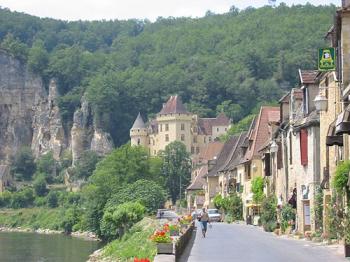
- The Dordogne Valley
For centuries, the Dordogne, the river of hope, has been a route ensuring the trade of wood and salt. Nowadays its valley is dedicated to agriculture: asparagus, corn, strawberries, melons, walnuts..., but it has also an industrial side: manufacturing of sleepers for the railroad, jam, confectionery. The traditional rural settlement generally adopts a type of high houses with a cattle shed or a wine cellar on the ground floor. The roof is built with a gable end or "à coyaux" (with 2 slopes and a curled edge), always covered with flat tiles.
- The Segala
The "Ségala" is a cool area between the "Massif Central" and the tablelands of Quercy which is the natural kingdom of the forest: beech, birch, and specially chestnut. It contains the highest part of the land between the Cère and the Dordogne, with a point at 524 m. The cultures of rye and chestnut have been replaced by animal breeding. This translates into an architecture which displays beautiful barns topped with pigeon lofts. The steep slopes of the roofs make it possible for the frame to support the weight of slate roofing stones, a typical staple of the areal.
- The "Causse" (tableland)
Land of stone, this arid chalky tableland covered with fragrant fields, where the famous Causse ewes "with sunglasses" graze. Here, the "small heritage" is plentyfull and unique, since it is made-out of piled-up dry stones, symbol of the know-how of the ancient builders. This typical environment accommodates a remarkable fauna and flora. Therefore the various tablelands of the Lot are regrouped under the label " Parc Naturel Régional des Causses du Quercy" (Regional Natural Reserve of the Tablelands of Quercy).
Accommodation nearby
Circuit of lights

In BRETENOUX, Julien Viaud, who is not yet known as Pierre Loti, spends enchanted summer hollidays at his "uncle from the South's", between 1861 and 1864. In 1861, he discovers Bretenoux: "Towards dusk, by one of these Southern rivers that splash on flat beds of white pebbles, we reached the strange small town which was the purpose of our trip. It still had its old ogival doors, its high ramparts with throw-holes, its streets framed by Gothic houses and the blood-red colour that was the original colour of the walls." There were..."The two streets that ended at my uncle's house, framed by houses from the Middle-Ages, both streets ending in front of an ogival door placed in the high, red stone wall"... It is a 13th century fortress which presents a remarkable architectural heritage with its arches, its ogival "Door of Guierle" and its 12th and 14th century houses, among which the Manor de Cère which accommodates the Town Hall, the Community of Communes and the Office of Tourism. The "Place des Consuls" (Consuls' square), surrounded by covered walkways and paved with cobbled stones, comes alive and colourful on market days (every Tuesday and Saturday morning). While strolling on the quays, you reach the island of "La Bourgnatelle", where taking a walk is a pleasure. (Take the D940 towards Biars-sur-Cère, then turn right on the D14 towards Biars- Bourg).
Bretenoux's neighbour BIARS-SUR-CERE, on the right bank of the Cère, shows 2 faces: an old peaceful village snuggled around its church, and an active modern city specialised in the manufacturing of compotes and jams (more than 50% of the nation's production).
By going up the river Cère on the D102, you find GAGNAC. The village, on your right, beyond the bridge, is an old strategic place on the way to Aurillac, on the bank of the Cère; an enclosure and a ditch used to protect the houses built around the 15th century Roman church which bears the signs of many attacks endured over centuries; it was rebuild at the same time as the village, in the 17th century, and was deprived of its bell-tower during the Revolution. The cemetery chapel keeps watch on the departed. Cross the bridge, and you see the harbour on your right ; it was used to unload the wood drifting down from Auvergne before reaching the tolls installed on the Dordogne river by the Baron of Castelnau. Salt also crossed the Cère at the Port of Gagnac, to be transported towards Cantal. At the Port, old houses are reflected into the waters of the Cère.
The D14, and then a left turn, will take you to CAHUS. Being the only commune of the Lot that lies in Quercy, Ségala (Auvergne) and Xaintrie (Limousin) at the same time, Cahus stretches from an altitude of 150 meters to one of 501 meters. With its roofing stones and serpentine walls, its chestnut-trees, birches, oaks and conifers, it is a haven of peace, very close to the splendid canyons of the Cère, while overlooking the valley of the Dordogne. Its 12th century church is dedicated to Saint Bonnet.
Go towards LAVAL-DE-CERE, home to such a beautifully wild area that it is nicknamed "Tahiti"... The post office occupies what once was Marshal Canrobert's family home. Born in Saint-Céré in 1809, he fought alongside Napoleon III.
This is where you leave the canyons of the Cère to go up to TEYSSIEU, on the D31. The 13th century feudal tower, remains of a fortress, is impressive in this charming, peaceful village sitting on a buttress of the "Massif Central". Beautiful period houses, with roofing stones, barn-cattle sheds with carved lintels, memorial crosses, fountains & wells, form the local heritage. There is a project to light the bridge and the trees by the river, at night.
Continuing on the D3, you leave the Ségala at ESTAL, where the small 19th century church is topped with a typical bell-tower-porch. The "Pech de Clédy", highest point of the canton, reaches 524 meters.
You reach GLANES, continuing on the same road. On the sunny slopes of the left bank of the Cère, the soil delivers a fruity, soft wine of ruby colour with strong character. There, you find the only "gariotte" with a roof of vine cuttings. The production of nuts and peaches is important, there. The church is always illuminated.
The D134 leads you to CORNAC, in the small Mamoul Valley (brook and affluent of the Dordogne), where steps with guard-rails lead up to houses with gabled, flat-tiled roofs; the medieval enclosure has disappeared, but the castle, altered in the 17th century, looks proud with its attic windows. The church raises an imperial dome with skylights, while below, a round tower with half-timbered logings shows the nobility of a residence.
Continuing on the D134, then turning left at the intersection, you arrive in BELMONT-BRETENOUX. The wall-belfry of this peaceful village church carries the ancient alarm bell of the tower of Castelnau. The village still shows the remains of an old oppidum, offering a superb panorama on the basin of Saint-Céré.
Go towards the D940 and cross it to go up to SAINT-MICHEL LOUBEJOU where you find houses with "souillardes" (traditional kitchens) and a superb church.
The D43 takes you to SAINT-MARTIN (commune of Prudhomat), where the church is projected to be lit-up, just like FELINES' (idem).
Listen to Pierre Loti speak to you about the CASTLE OF CASTELNAU: "... perched, slicing the air with the reddish cluster of its terraces, its ramparts, its towers and its turrets... It was... the bench-mark of the region, the thing one saw from everywhere: this stone, blood-coloured lace emerging from a tumble of trees, this ruin laid as a crown on a green pedestal of chestnut-trees and oaks. "
At the foot of the fortress, PRUDHOMAT, a very large commune, is rich in architectural heritage: in addition to the 2 already mentioned churches, the project of night illumination involves the bottom of the BONNEVIOLE dam, its church and the bridge of Maday. In PAULIAC, on the banks of the Dordogne, the church is already lit.
On the left bank of the Dordogne (D30), GINTRAC is dominated by the ruins of Taillefer. This Knight Templers' fortress, probably built by Raymond V, Count of Toulouse, to whom belonged the "Bastit du Causse" (fortress of the tableland). It took the name of his second son, nicknamed "Taillefer" (steelcutter)... Later, a leper-house was installed there; a letter of the Pope dated of 1539 attests the existence of this quarantine station. The church and the laundrette are the object of an illumination project.
After crossing the Dordogne river, just before Carennac, while following the D30, it is necessary to go back towards TAURIAC, on your right. This very old village is located in the alluvial valley of the Dordogne, where the soil is favourable to mixed-farming (asparagus...). Saint Martin's church preserves remarkable 16th century frescos. A tributary of the Dordogne, subject of a study for classification as a natural reserve, feeds a very popular pond in the summer.
Proceed to PUYBRUN, called "new fortress of Tauriac" in the past, built on the ground of "Las Olmièras" in "Podii Brunii" in 1280. The church, destroyed and rebuilt over several centuries, was strengthened in order to contribute to the defence of the fortress, if necessary.
The D703 and then a right turn brings you to the end of your tour, to GIRAC. From This point, you can return quickly to Bretenoux.
Accommodation nearby
The monuments for visiting
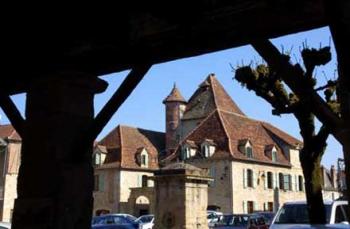
Come to discover many monuments Brtenoux
- Bastide Bretenoux
- Ruins of Taillefer
- The feudal tower of Teyssieu
- Frescos of Tauriac
- Turns of the St. Lawrence
- Castle of Montal with St Jean Lespinasse
- Castle of Castelnau-Bretenoux, in Prudhomat
- Castle of Assier
- Castle of Lacapelle Marival
- Castle of Treyne with Lacave
- Castle of Fénelon * Ramparts of Rocamadour
- Gardens of the manor of Eyrignac
Accommodation nearby
Latest news on : Welcome to Bretenoux
Tourism near
 Visit the city of Bretenoux
Visit the city of Bretenoux - 1 Museum
- 5 Monuments
Tours
 Discovering France’s most beautiful villages
Discovering France’s most beautiful villages
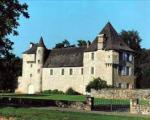 Beaulieu-sur-Dordogne
Beaulieu-sur-Dordogne






















